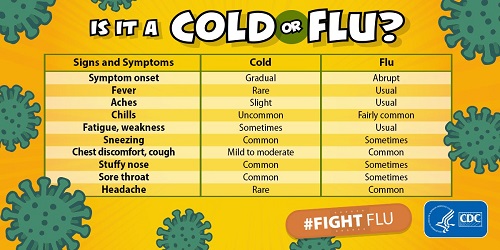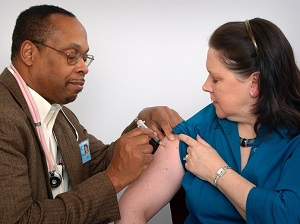If you don't have a fever, it can be difficult to tell the difference between cold and flu symptoms. Seasonal flu usually comes on suddenly, while a cold may develop more gradually. Learn more about the signs and symptoms of seasonal flu, why it's different than a cold, and the best way to prevent it every year.

What is the Flu?
Seasonal flu is a contagious respiratory illness caused by influenza viruses that infect the nose, throat, and lungs.
According to the CDC, most experts believe that the flu is spread when people who already have the virus cough, sneeze or talk near others. The flu can also sometimes be spread by touching a surface that has the flu virus on it, and then touching one’s face.
Someone can be contagious 1 day before they develop flu symptoms and up to 5 to 7 days after becoming sick.
Flu season starts around October and lasts until May, but most flu activity occurs in the months of December, January and February every year.

Flu Symptoms
The flu usually comes on suddenly, with some or all of these symptoms:
- fever or feeling feverish/chills
- cough
- sore throat
- runny or stuffy nose
- muscle or body aches
- headaches
- fatigue (tiredness)
Most people who get the flu will recover in a few days and almost always within two weeks, but some people may develop complications, like pneumonia, that can end up being life-threatening, which is why it is important to take the flu seriously and not continue to ‘work through it’.
If flu symptoms do not subside, seek immediate medical attention if any of these symptoms occur:
- difficulty breathing
- persistent pain in the chest or abdomen
- lack of urination
- persistent confusion or dizziness
- seizures
- severe muscle pain or weakness
- chronic medical conditions that get worse

What to Do if You Get the Flu
Most people with the flu do not need medical care or antiviral drugs. If you get sick with flu symptoms, in most cases, you should stay home and avoid contact with other people, except to get medical care.
If you have the flu, stay home and recover. Do not go to work and risk infecting your co-workers.
STOP THE SPREAD OF GERMS AT WORK AND AT HOME
- Avoid close contact with sick people.
- Stay home and away from others when you’re sick.
- Avoid touching your eyes, nose, or mouth.
- Cover your mouth and nose with a tissue when coughing or sneezing.
LEAD BY EXAMPLE
- Get vaccinated annually.
- Encourage co-workers and family to get vaccinated.
- Practice good health habits.

According to the CDC, prevention is better than cure when it comes to any illness, including the flu. Every year, on average, 5% - 20% of the population gets the flu and this costs billions of dollars annually.
The flu can make anyone sick, even those people that usually seem strong and healthy. Employees should get their flu shot annually to help protect themselves against this illness and also to prevent unexpected lost time from work.
Flu Vaccines
Flu vaccines have a good safety record. Hundreds of millions of Americans have safely received flu vaccines over the past 50 years, and there has been extensive research supporting the safety of flu vaccines.
A flu vaccine is the first and best way to reduce your chances of getting the flu and spreading it to others. The CDC recommends everyone 6 months and older receive a yearly flu vaccine as the first and most important step in protecting against the flu.

TIPS TO REMEMBER DURING THE FLU SEASON:
- Get the flu vaccine annually.
- Encourage those around you to get the flu vaccine.
- Practice good health habits, wash hands often.
- Stay home and away from others if you are sick.
- Seek medical attention if symptoms are severe.
- Avoid close contact with others that are sick.
- Take antiviral medication if prescribed.
- Take time to recover, don’t ‘work through it’.
Persons with the flu are most contagious during the first 3 days of their illness.
If you become sick with the flu, stay home until at least 24 hours after your fever is gone without the use of fever-reducing medicines.
If you are diagnosed with or suspect you have the flu but do not have fever as a symptom, stay home from work at least 4-5 days after the onset of symptoms.


.jpeg)
